Northeast
New Yorkers rail on losing battle against crime after Gov. Hochul dispatches National Guard
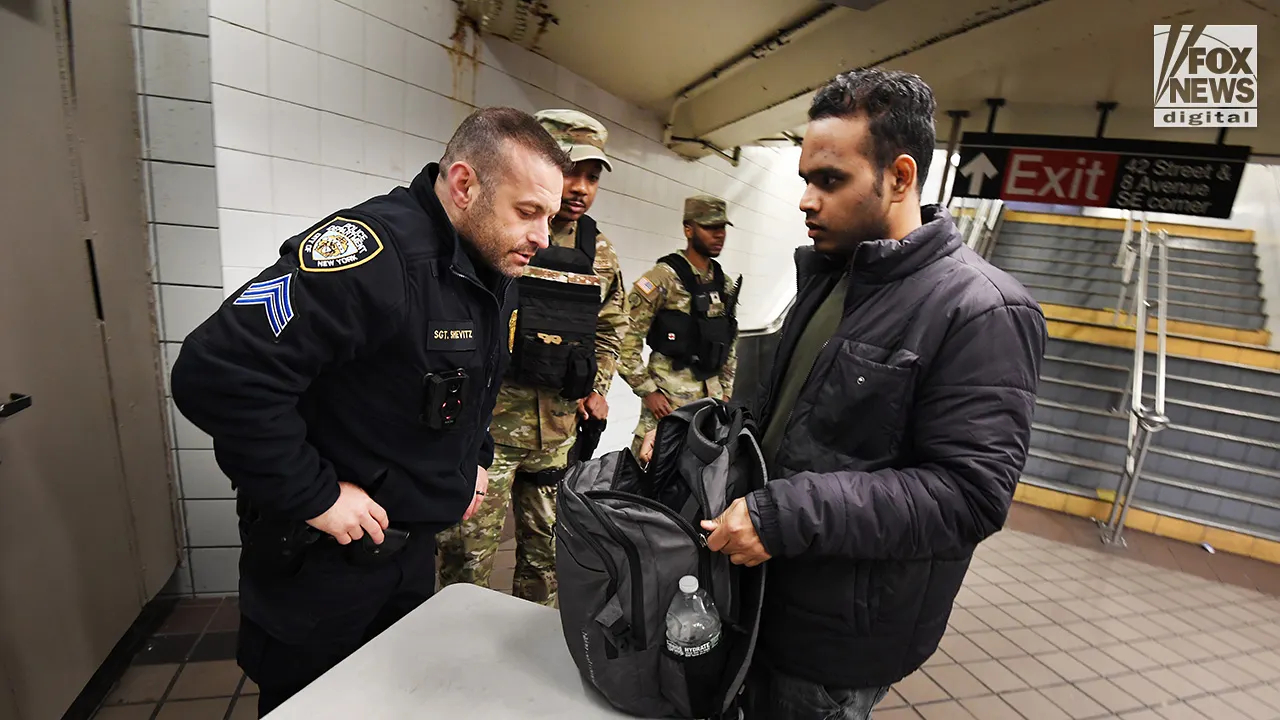
NEW YORK CITY – New York subway riders are weighing in after Gov. Kathy Hochul sent in the National Guard and state troopers to help the NYPD secure Big Apple subway stations amid fears of crime and chaos.
Many support the move after recent mayhem included surveillance video showing a man at a Manhattan subway station hurling flaming cans at people through a turnstile.
The week capped off with dramatic eyewitness video of a man shot in the head with his own gun after a brawl in a packed subway car.
On Friday, the NYPD revealed the victim also displayed a knife or razor blade during the scuffle, and did not pay the fare at the turnstile.
WATCH: Terrified passengers record subway shooting
Random shoving attacks on the city’s subway platforms have also left people killed or severely injured by oncoming trains, and last week an ex-con was accused of ditching his ankle monitor before shoving his ex into a moving train in Manhattan during an argument.
An NYPD officer patrols a subway station in New York City Monday, March 11, 2024. Gov. Kathy Hochul announced a five-point plan earlier this month, deploying 750 members of the National Guard to combat a near 20% rise in crime levels throughout the subways. (Matthew McDermott for Fox News Digital)
BODYCAM VIDEO SHOWS NYPD OFFICERS SPRING INTO ACTION TO PULL MAN FROM SUBWAY TRACKS
A conductor who survived having his neck slashed at random on the job told the New York Post over the weekend he never plans to get on another subway train.
“It’s not safe.”
And straphangers have reported incidents of indecent exposure and other deviant behavior they say increased police patrols would combat.
WATCH: New York straphangers weigh in on subway crime
“It’s not safe,” one rider, Gabriela, told Fox News Digital this week.
Another rider, Tally, said she avoids the trains at night and prefers to take an Uber during off hours.
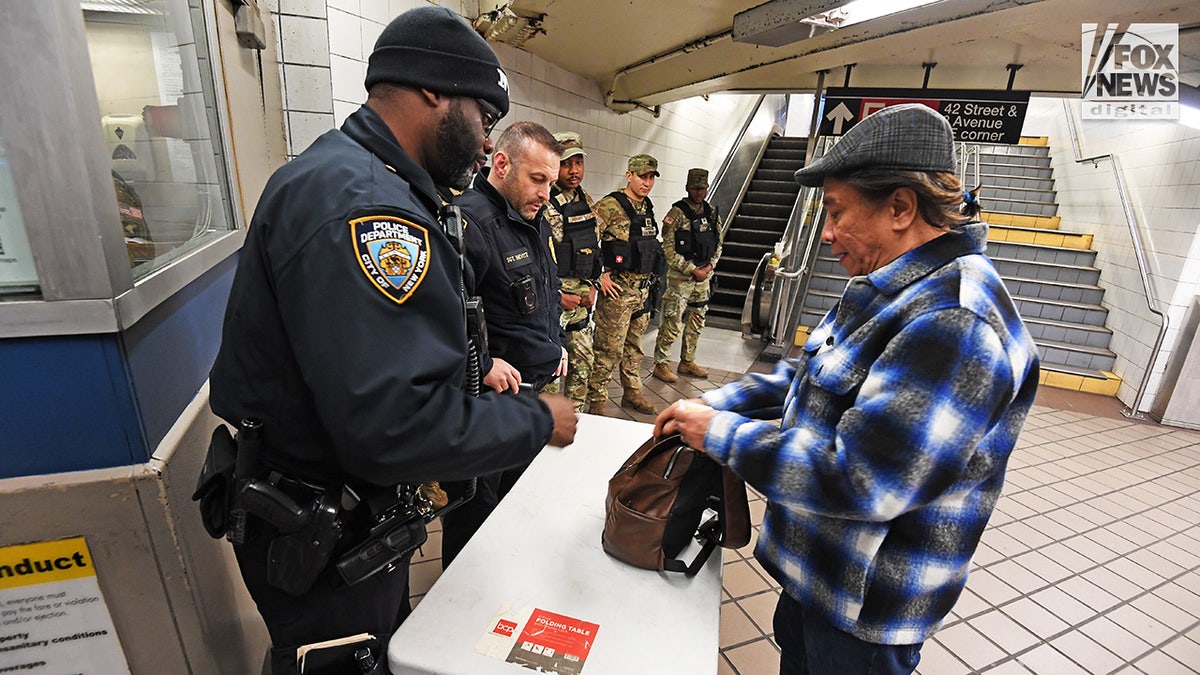
Members of the NYPD and National Guard conduct random bag searches in New York City’s subway system Monday, March 11, 2024. (Matthew McDermott for Fox News Digital)
“We need more jobs in this country, so they should hire more officers,” added David.
VIDEO: Man throws cans of fire at strangers in NYC subway station
GOV. KATHY HOCHUL HITS BACK AT CRITICS OF SENDING NATIONAL GUARD TO PROTECT NYC SUBWAYS: ‘I’M NOT BUYING IT’
NYPD crime statistics show robberies and transit crime have both risen in the Big Apple so far in 2024 compared to last year, and the string of high-profile violent incidents have travelers on edge.
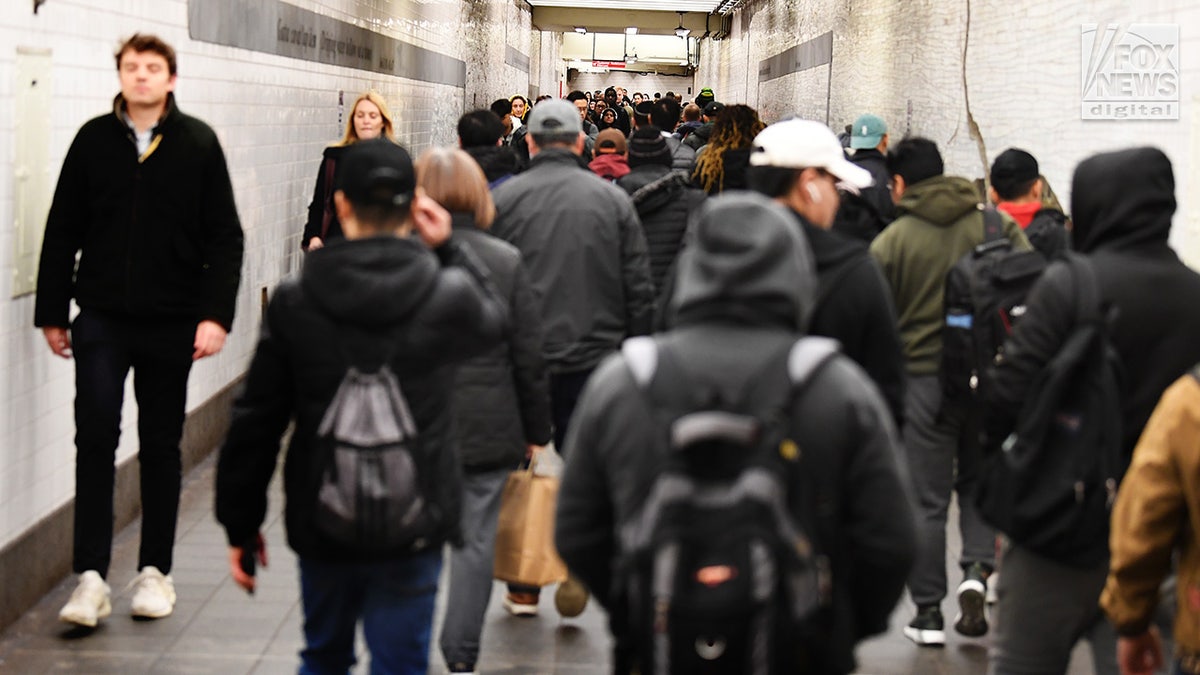
Commuters travel through a subway tunnel in midtown Manhattan on Monday, March 11, 2024. (Matthew McDermott for Fox News Digital)
“I think no one really feels safe,” Tally said. “But I see officers and I see an effort being made. So, I don’t know. I don’t know where the solution would be.”
Hochul sent the National Guard last week to assist the NYPD with random bag checks, which were reimplemented by Mayor Eric Adams in an effort to curb the violence.
“For people who are thinking about bringing a gun or knife on the subway, at least this creates a deterrent effect,” she told reporters March 6. “They might be thinking, ‘You know what, it just may just not be worth it because I listened to the mayor and I listened to the governor, and they have a lot more people who are going to be checking my bags.’”
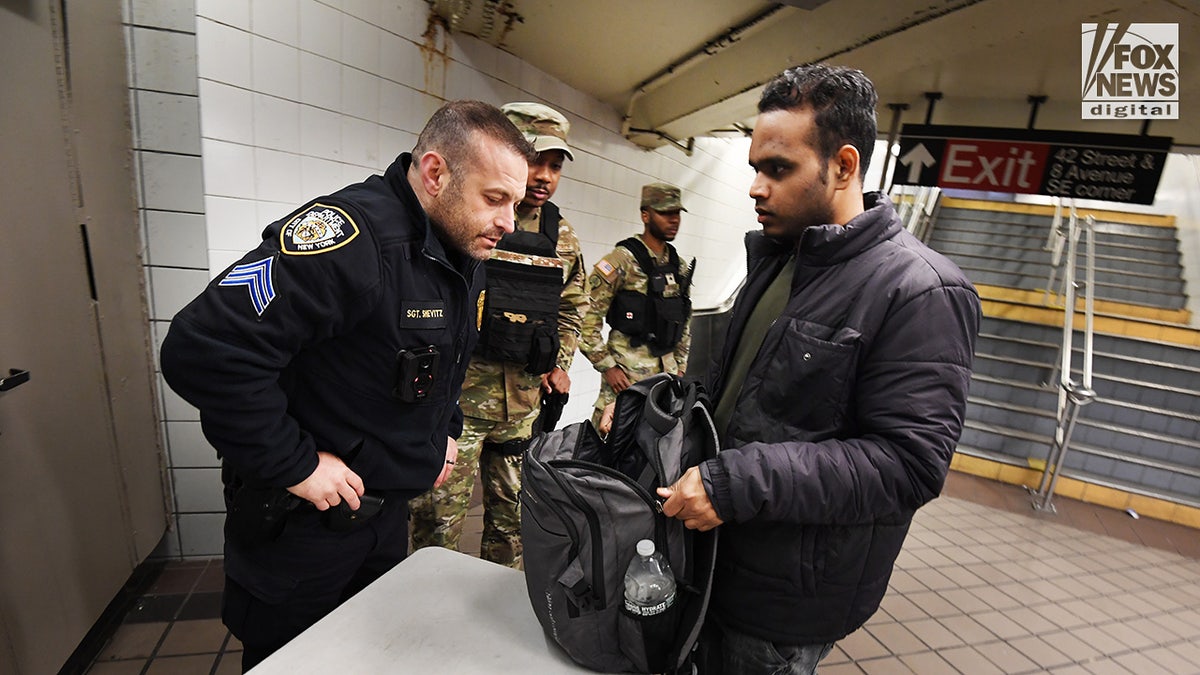
Members of the NYPD and National Guard conduct random bag searches in New York City’s subway system Monday, March 11, 2024. (Matthew McDermott for Fox News Digital)
She also proposed a law that would ban people from the subway system if they are convicted of assaulting a fellow passenger and adding cameras to trains after the conductor slashing.
Adams also announced he would increase NYPD patrols on the subway system to fight the crime spike. And amid those increased patrols, NYPD officers were already able to rescue a man who fell onto tracks in the Bronx before a train arrived.
LONG ISLAND BODY PARTS SUSPECTS FREED AGAIN UNDER NEW YORK BAIL RULES
WATCH: NYPD officers spring into action to save man from subway tracks
But not everyone was receptive to the bag checks, which prompted some angry grumbling from commuters running late.
Another potential straphanger turned around when he saw the bag station, even though authorities had not stopped him at random.
EX-CON NYC MURDER SUSPECT SMILES WITH DA BRAGG SHORTLY BEFORE SHOCKING ARREST
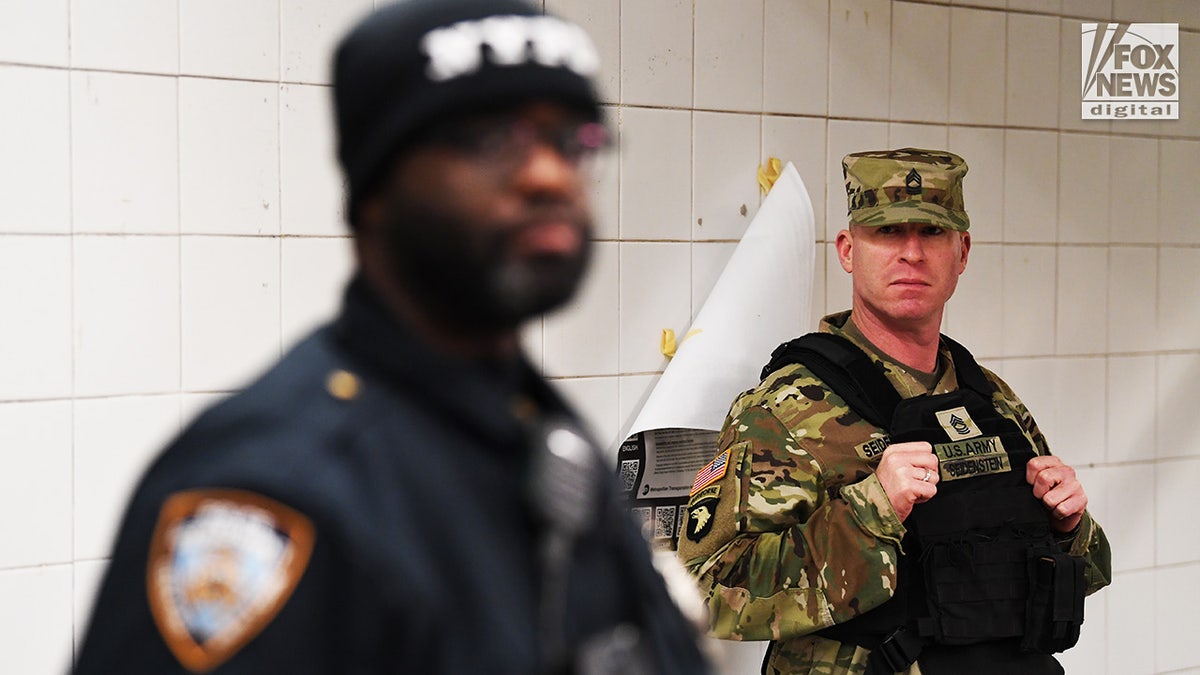
Members of the NYPD and National Guard patrol the subway system in New York City Monday, March 11, 2024. (Matthew McDermott for Fox News Digital)
He declined to give his name but said he escaped communist Romania as a child and came to the U.S. He called the bag checks “unconstitutional.”
“It doesn’t matter what your politics are,” he said. “They need probable cause to search you.”
With transit crime plaguing the city, critics of progressive district attorneys in four of the five boroughs have complained about low- and no-bail releases of repeat offenders while a Marine Corps veteran is being prosecuted in the death of an erratic passenger who was terrifying fellow riders in May.
NYC MAN SCREAMING ABOUT KNIFE, HOLDING MOTHER IN CHOKEHOLD SHOT DEAD ON NYPD BODYCAM
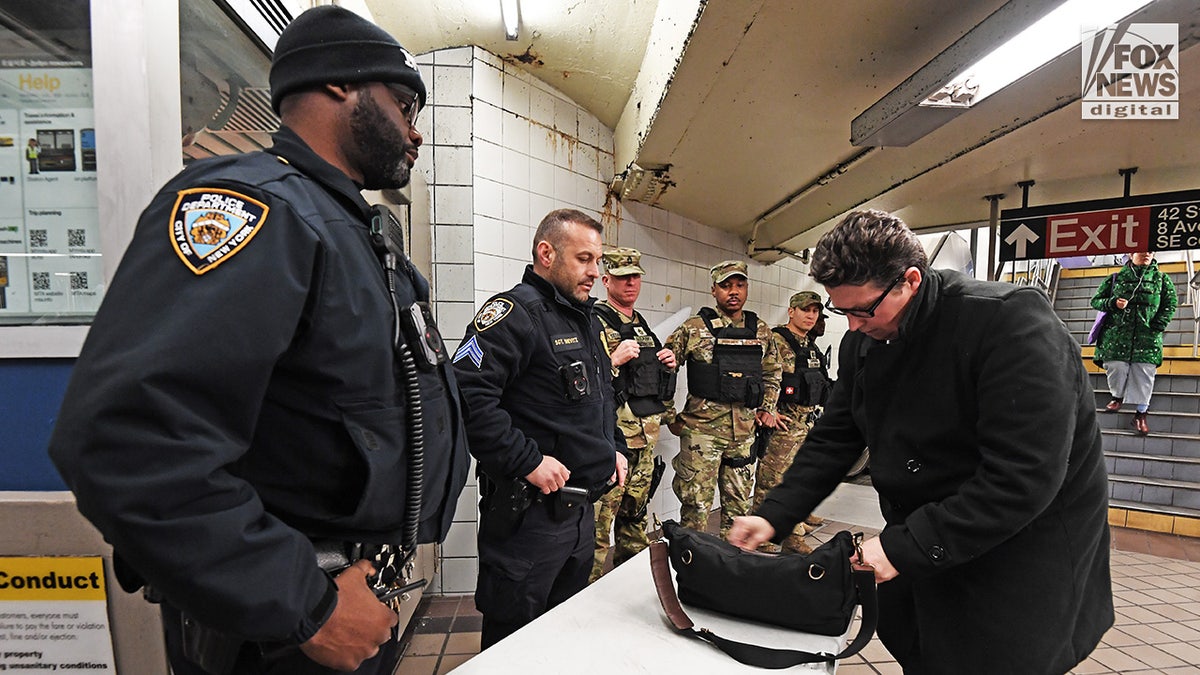
Members of the NYPD and National Guard randomly search bags in New York City’s subway system Monday, March 11, 2024. (Matthew McDermott for Fox News Digital)
Daniel Penny, 24, is facing charges of manslaughter and criminally negligent homicide after he placed Jordan Neely, 30, in a chokehold while Neely was shouting at and threatening passengers on a Manhattan F train. Neely, who had dozens of prior arrests, including multiple subway assaults, died in the encounter.
US MARINE VET DANIEL PENNY PLEADS NOT GUILTY TO MANSLAUGHTER IN CHOKEHOLD DEATH OF JORDAN NEELY
Penny has been released on $100,000 bail and is due back in court next week.
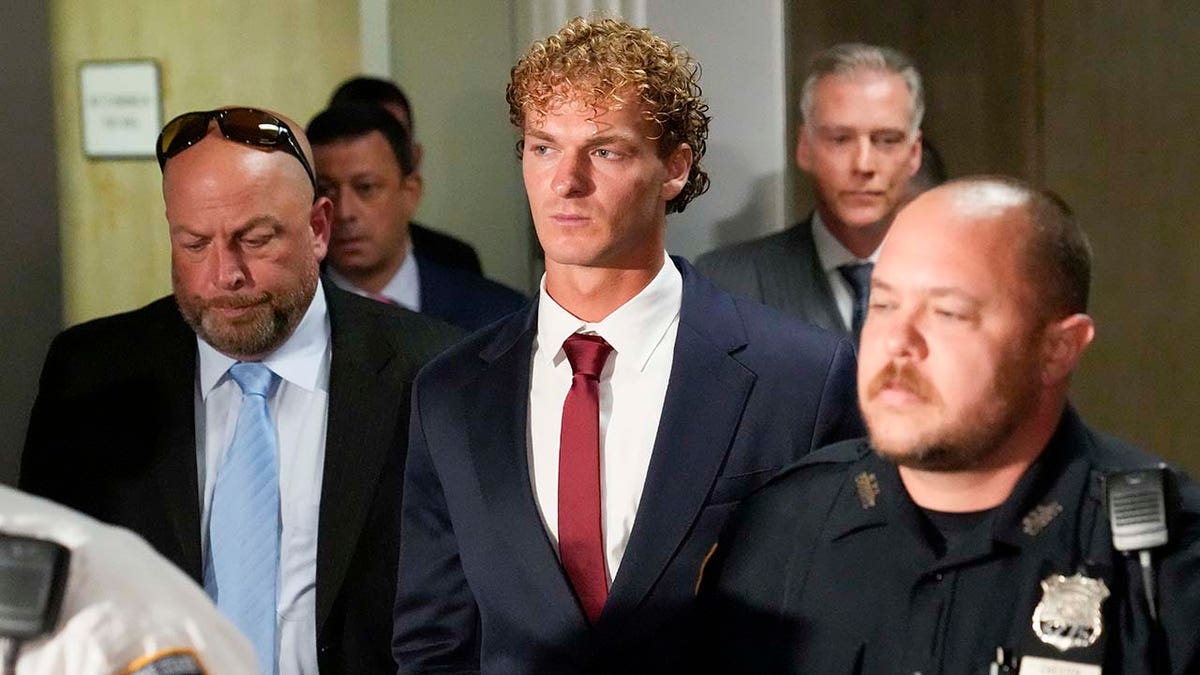
Daniel Penny departs Manhattan Criminal Court following his arraignment, June 28, 2023, in New York. (AP Photo/John Minchillo)
“I’m not comfortable with my wife and my children taking the subway right now,” said Staten Island attorney Louis Gelormino. He said the city’s crime problems began spiraling out of control after Bill de Blasio abandoned the tough-on-crime policies of his predecessors, Rudy Giuliani and Mike Bloomberg.
“We have to have the [National Guard] to go there and protect our subways when we have the best police department in the entire world, to navigate that system and protect us, is ridiculous.”
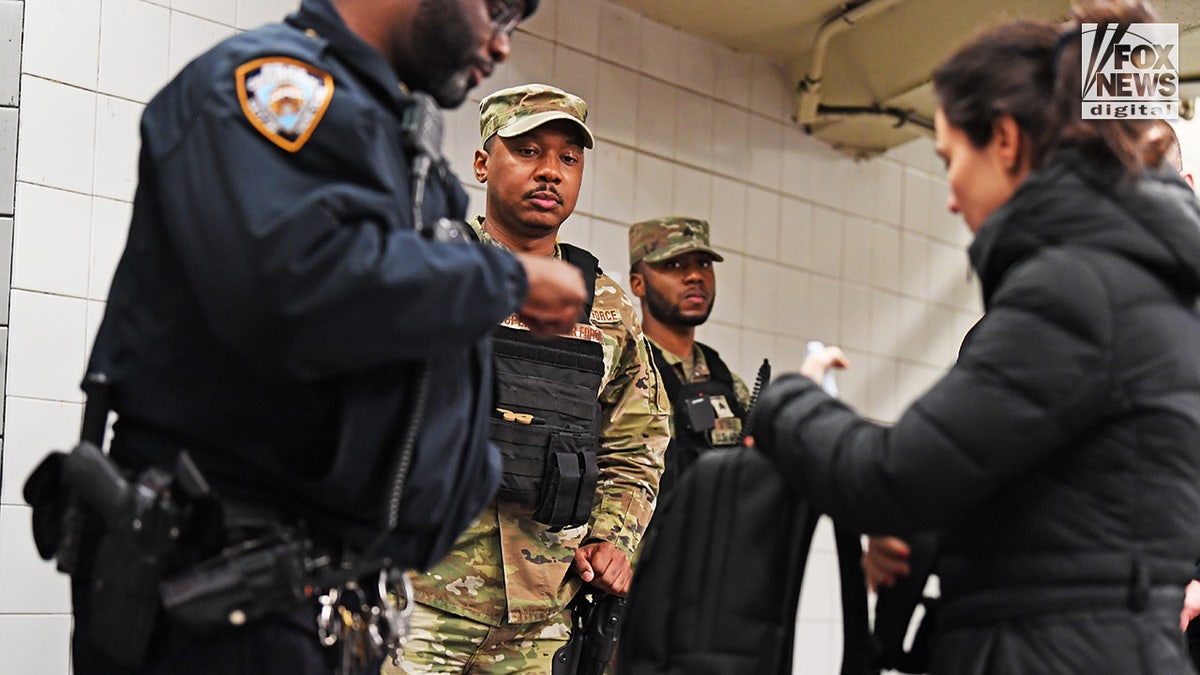
Members of the National Guard and the NYPD randomly search bags in New York City’s subway system Monday, March 11, 2024. (Matthew McDermott for Fox News Digital)
In addition to hiring more police, he said, New Yorkers could try electing new district attorneys.
“Other than Mike McMahon in Staten Island, who happens to do a very good job, the district attorneys in this city have all fallen under that major liberal, progressive attitude where they don’t want to prosecute crimes,” Gelormino said. “And it seems like they’re very selective on who they prosecute crimes against. We need to vote for different district attorneys.”
The subways appeared unusually empty outside rush hour Monday.
The city is losing tens of thousands of residents as illegal immigrants and migrants continue to pour in.
About 78,000 people ditched the Big Apple in 2023, The New York Times reported Thursday. That’s on top of 126,000 in 2022, and more than half a million residents left between April 2020 and July 2023, according to the paper.
Fox News’ Michael Dorgan contributed to this report.
Read the full article from Here

Boston, MA
Boston’s heating up! Here’s when temps will top 90 again
Pittsburg, PA
Pittsburgh leaders hold hearing on emergency response and readiness for severe weather
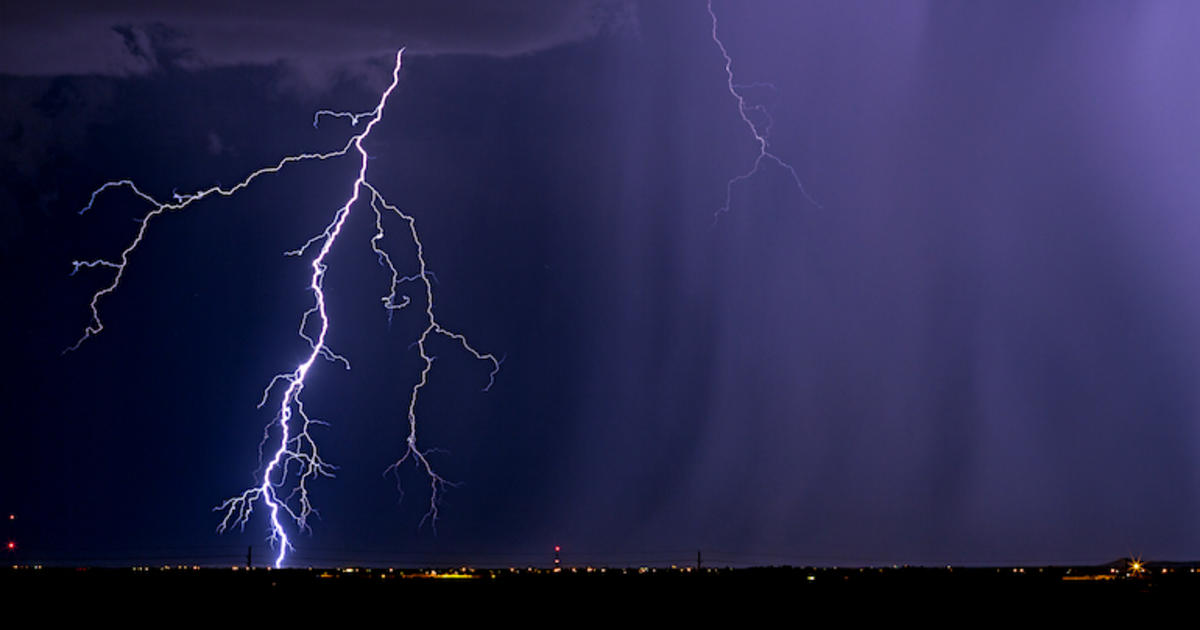
The intense windstorm that hit western Pennsylvania in April is still on the minds of Pittsburgh officials and emergency responders.
They met for a hearing on emergency response and readiness on Wednesday, when they discussed the challenges they faced and what they’re hoping to improve before the next severe weather event.
Some emergency officials said what swept through the Pittsburgh region on April 29 was the worst storm they’ve seen in their careers. The system caused widespread power outages, and many lasted for days.
“This storm really only lasted about 10 minutes, was really the duration of this storm to do all this damage,” said Alan Hausman with Pittsburgh’s Office of Emergency Management and Homeland Security.
Pittsburgh City Councilwoman Erika Strassburger, who called for Wednesday’s hearing, said it was an opportunity to understand how the city prepared, how it responded, what challenges it faced, what lessons were learned and what improvements are necessary moving forward.
Emergency leaders shared some problems they faced, including safety concerns with power lines down in fallen trees.
“We could not send [Department of Public Works] units out to those areas to start clearing those trees until we knew for a fact that they were deenergized,” said Adam Ameel, Pittsburgh’s Deputy Emergency Management coordinator. “And it’s not just a matter of knowing that they’re denenergized, but they’re coordinated with Duquesne Light, so they’re not reenergized while they’re working on them.”
Phone systems were also clogged that day.
“There was mention that our 911 operations were not operational that day, which couldn’t be further from the truth. We were completely operational. What had happened was the immense call volume that came through in such a short amount of time overwhelmed the state’s 911 phone system, and I’ve conferred with PEMA about this,” Allegheny County Emergency Services Chief Matthew Brown said. “We saw over 6,700 calls for service to Allegheny County 911 in an hour. One minute in that hour, we saw over 1,000 calls.”
There were also high numbers of people needing oxygen.
“This medical-grade oxygen caught us all off-guard, not thinking that over the years so many people who were reliant on oxygen have converted to these electrically-driven oxygen generators,” Brown said.
“We got a tremendous number of calls of people who were losing their oxygen concentrators. They weren’t functioning, they didn’t charge their batteries the day before, they had oxygen in those but didn’t have regulators for them. What we were able to do was take the oxygen we keep in our mass casualty unit, immediately get those out to those folks and put a rapid response unit together,” Hausman said.
Officials said they also dealt with power outages at city facilities.
“Some of the things that we think we can improve on, one, is hardening the city’s facilities. We had fire departments and fire stations, EMS stations, and police stations out of power for an extended amount of time,” said Pittsburgh Bureau of Fire Chief Darryl Jones, who is also the city’s emergency management coordinator.
“We’re developing a plan for how we can improve that, whether it is a mission-ready package that we deploy generators to those facilities, or we have actual built-in generators,” Pittsburgh’s Director of Public Safety Lee Schmidt said.
Chief Jones said they did a complete after-action review to identify what worked well and what needs improvement; and they’ll be working to make those improvements for the next bad storm.
“The goal of this hearing is not only to learn from the storm but to build a stronger, more resilient city and system that protects all Pittsburghers, particularly our most vulnerable neighbors,” Strassburger said.
Strassburger told KDKA the last portion of the meeting focused on future planning and next steps. She also said Chief Jones would be sending the post-event report to council, clarity around internal communication with council before and during an emergency, and possible emergency preparedness training for council members and staff.
Strassburger said Councilwoman Barb Warwick has called for a separate post-agenda hearing about Duquesne Light’s response, and that’ll happen at a later date.
Connecticut
Opinion: As CT focuses on housing crisis, eviction protections can’t be forgotten

Everyone needs a place to live. That is something not seriously debated or disputed by Connecticut policymakers.
What was debated, disputed-–and in the end, discarded–- is the idea that the places people live should not be suddenly, and without justification, taken away from them.
“Just Cause” eviction protections, which prevent landlords removing a tenant without cause, already exist for seniors (age 62 and up) and people with disabilities in this state. Five states, including our neighbors in New Hampshire and New Jersey, already require landlords to give a reason for evicting any tenant. Importantly, the bill would have only applied to properties with five or more units and would not have affected small local landlords.
Why couldn’t Connecticut, facing our own growing crisis with housing and homelessness, take this step to provide stability for families–who already face spiraling rental costs–and prevent price-gouging practices by unscrupulous landlords?
State Rep. Antonio Felipe told the CT Mirror last month that he believed “we have the votes.” But somehow, the vote never happened. According to Felipe, that’s because too many lawmakers were afraid to be “public” with their support of “Just Cause.”
Protecting Connecticut families from arbitrary evictions should not be something legislators on either side of the political spectrum shrink from. The idea that a tenant who pays rent on time and follows all the rules should keep their living space cannot be controversial. Opponents to this measure, led by deep-pocketed landlords, claimed counter-intuitively (and bizarrely) that these measures would worsen the housing crisis by disincentivizing landlords from maintaining properties, leading (somehow) to a decrease in housing units.
Connecticut’s housing crisis is finally being acknowledged broadly, with a huge dearth of affordable places to live and high costs squeezing families in nearly every town. But it is vital to remember this crisis is not about properties, it is about people.
While building more living spaces remains essential, we cannot expect renters (largely young people) to thrive in our state under the constant threat of being forced from their homes. Career prospects, school performance, community connections -–all hinge on a stable living space. It would be deeply misguided, and dangerous, to continue working on other aspects of the housing crisis without shoring up the foundation.
-

 Politics1 week ago
Politics1 week agoConstitutional scholar uses Biden autopen to flip Dems’ ‘democracy’ script against them: ‘Scandal’
-

 Politics1 week ago
Politics1 week agoDOJ rejects Ghislaine Maxwell’s appeal in SCOTUS response
-

 Health1 week ago
Health1 week agoNew weekly injection for Parkinson's could replace daily pill for millions, study suggests
-
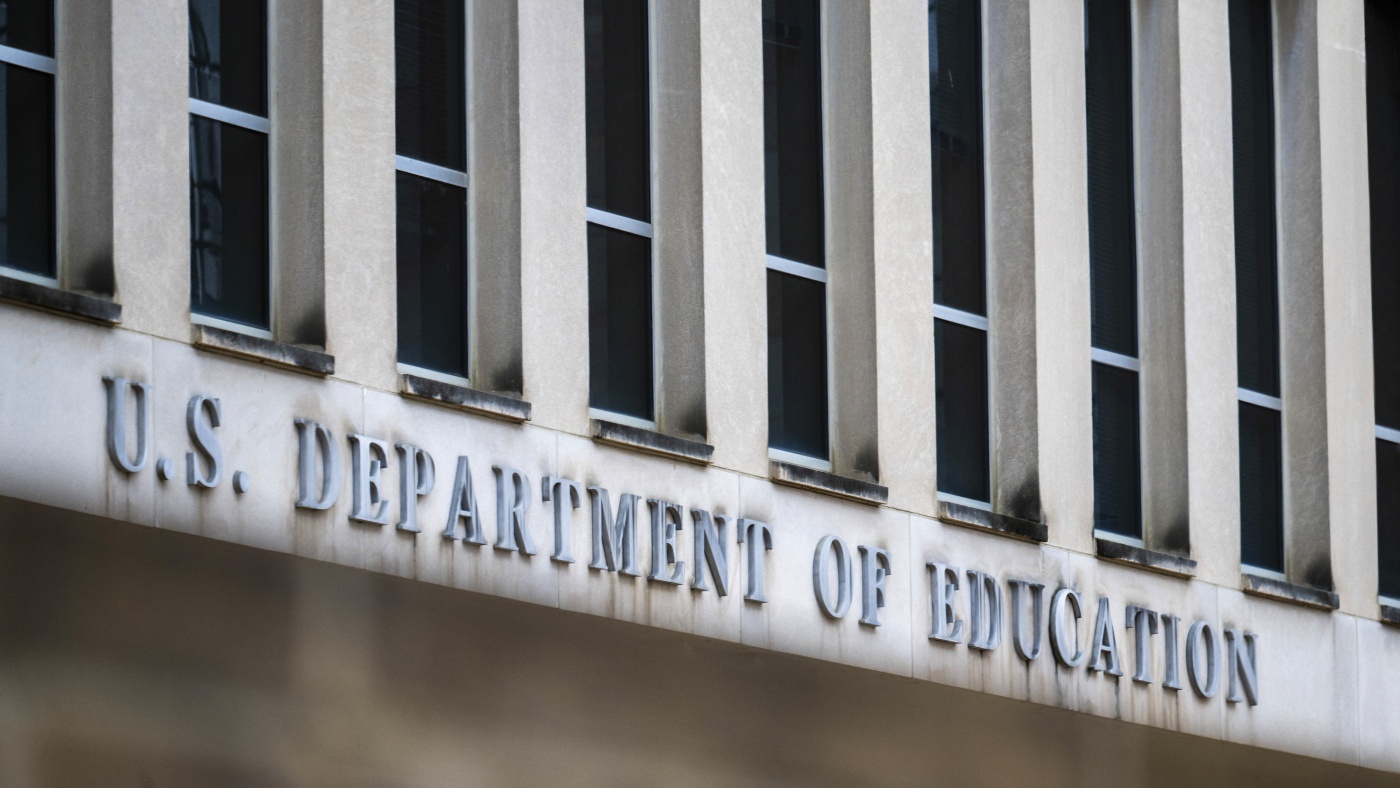
 News1 week ago
News1 week agoSCOTUS allows dismantling of Education Dept. And, Trump threatens Russia with tariffs
-

 Culture1 week ago
Culture1 week agoTest Your Knowledge of French Novels Made Into Musicals and Movies
-

 Business1 week ago
Business1 week agoShould You Get a Heat Pump? Take Our 2-Question Quiz.
-
Business1 week ago
Musk says he will seek shareholder approval for Tesla investment in xAI
-

 Sports1 week ago
Sports1 week agoEx-MLB pitcher Dan Serafini found guilty of murdering father-in-law
















